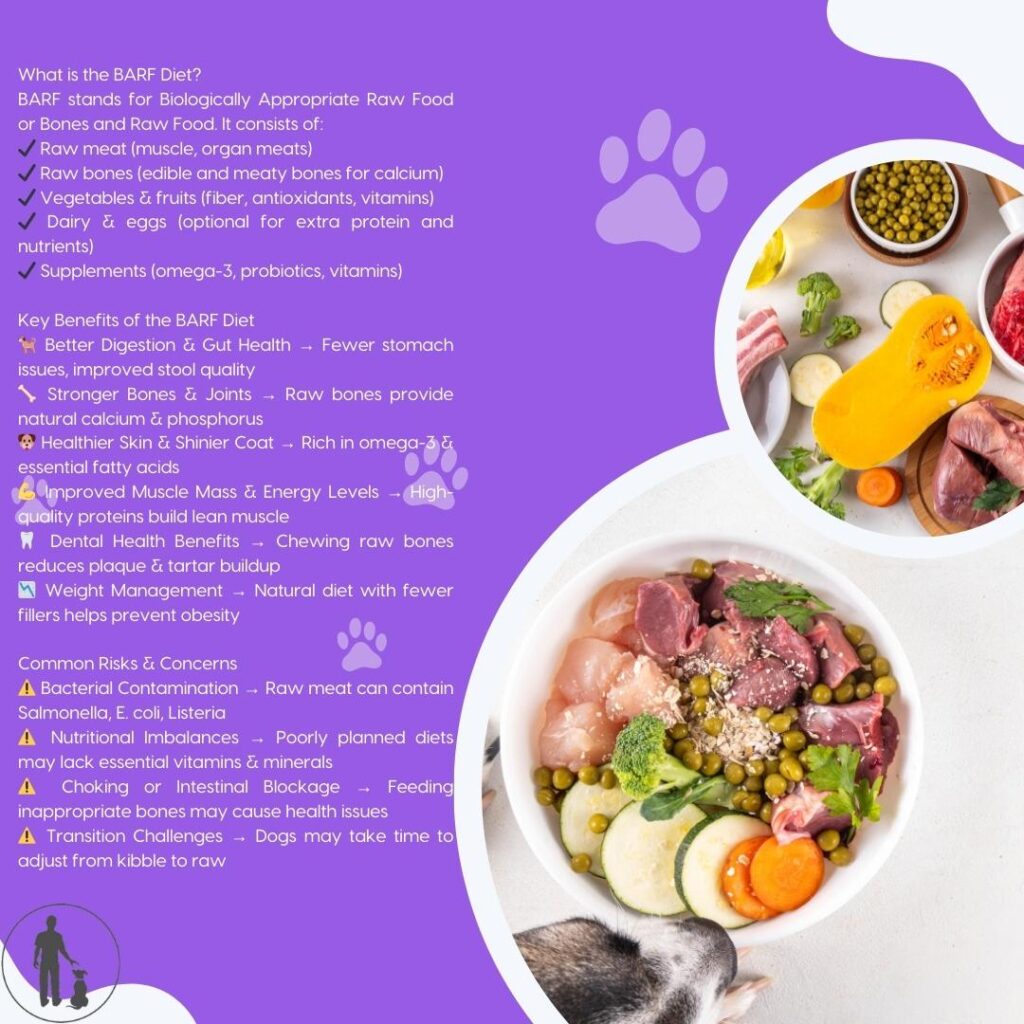Understanding the BARF Diet Fundamentals
Definition and Core Principles
The Biologically Appropriate Raw Food (BARF) diet is formulated to replicate the natural eating habits of dogs, rooted in the concept that canines are primarily carnivores. RAW food supporters believe that feeding dogs raw meat, bones, organ meats, vegetables, and supplements can more closely meet their biological needs and promote optimal health. The primary aim of the BARF diet is to provide nutrients in their most natural and bioavailable form, as what dogs would consume in the wild.
Key Components
To better understand the BARF diet, let’s break down its key components:
Raw Meat
Raw meat, which forms the bulk of the BARF diet, typically includes muscle meat from various animals such as chicken, beef, and lamb. This component is rich in protein, essential amino acids, and the moisture that dogs need.
Bones
Including raw, meaty bones in the diet is essential for calcium intake and maintaining dental health. As dogs chew on bones, it helps reduce plaque build-up and supports strong teeth and gums.
Organ Meats
Organ meats like liver, kidneys, and heart are some of the most nutrient-dense parts of the animals. They provide a concentrated source of vitamins (especially A and B vitamins), minerals (such as iron), and other essential nutrients.
Vegetables
Vegetables are included in the BARF diet primarily for their fiber content and for additional vitamins and minerals. Common choices include carrots, spinach, and sweet potatoes. These help to mimic the stomach content of their prey in the wild, which would contain partially digested plant material.
Supplements
To ensure a well-rounded diet, various supplements may be added. Fish oil is commonly used for healthy fats and omega-3 fatty acids. Additionally, probiotics, kelp powder, and other nutrients help to fill any nutritional gaps.
Historical Context and Evolution of Dog Feeding Practices
Historically, domestic dogs were fed raw diets before the advent of commercial pet food. Early dogs, living closely with humans, scavenged on scraps that included raw animal parts. This approach to feeding changed significantly with the rise of commercial pet foods in the mid-20th century. Processed kibble became popular due to its convenience, affordability, and extended shelf life.
However, many pet owners have started questioning the nutritional adequacy of these processed foods. They are turning back to raw diets in an effort to provide their pets with more natural and biologically appropriate nutrition. There is now a resurgence in interest in raw feeding, driven by a belief that such diets can lead to better health outcomes and quality of life for dogs.
Transitioning from commercial to raw diets requires a commitment to understanding and meeting a dog’s full nutritional needs. Properly implemented, the BARF diet promises numerous health benefits, which we will delve into in future chapters. These benefits can span everything from coat health and digestion to energy levels and immune system support.
An in-depth exploration of the scientific evidence supporting raw feeding will help substantiate these claims further. This next section will highlight relevant studies, compare health outcomes, and examine the impact on canine digestion and gut microbiota diversity.
Scientific Evidence Supporting Raw Feeding

Nutrient Bioavailability in Raw vs. Processed Foods
When it comes to feeding our canine companions, the bioavailability of nutrients is a major consideration. Studies indicate that dogs on a raw diet provided more easily absorbed nutrients compared to those on processed kibble. The raw diet is typically richer in natural proteins and moisture, enhancing the absorption of vital nutrients. This increased bioavailability means dogs can reap more benefits from the nutrients they consume, contributing to overall better health.
For instance, proteins found in fresh, raw meat are more likely to be fully utilized by a dog’s body, leading to improved muscle development and maintenance. Additionally, raw diets often contain higher levels of natural enzymes which can aid in digestion and absorption of nutrients.
Health Outcomes: BARF vs. Kibble-Fed Dogs
Comparative studies highlight some potential benefits of the BARF diet (Biologically Appropriate Raw Food diet) over traditional kibble feeding. According to research, BARF-fed dogs may exhibit fewer health problems, particularly obesity and related diseases, than their kibble-fed counterparts. One key finding is that dogs on raw diets may have lower incidences of chronic conditions, such as skin allergies and digestive issues.
Moreover, some longitudinal studies suggest that dogs fed a raw diet from a young age develop better muscle mass and exhibit improved overall health compared to those fed commercial kibble. These health benefits are not just anecdotal; they have been observed in controlled scientific studies, indicating a tangible positive impact of raw feeding on canine health.
Impact on Canine Digestion and Gut Microbiota Diversity
The digestive health of dogs can greatly benefit from a raw diet. Dogs with food sensitivities often show notable improvements when switched to a BARF diet, suggesting that raw food is easier on their digestive systems. The higher moisture content and presence of natural fibers in raw food help enhance stool quality and reduce gastrointestinal problems like bloating and constipation.
One of the most fascinating aspects of raw feeding is its impact on gut microbiota diversity. A healthy gut microbiome is crucial for a robust immune system and overall well-being. Raw diets can support a more diverse and balanced gut microbiota due to their unprocessed nature, which preserves the natural enzymes and probiotics present in the food. These elements are often lost during the processing of commercial pet foods.
Additionally, research indicates that a raw diet can increase the presence of beneficial bacteria in the gut while reducing harmful bacteria levels. This balanced microbial environment supports better digestion and boosts the dog’s immune defense, making them less susceptible to infections and illnesses.
Understanding the scientific evidence supporting raw feeding is crucial for any pet owner considering this dietary approach for their dog. These studies collectively underline the potential advantages a raw diet can offer, from improved nutrient absorption and digestive health to a more diverse and robust gut microbiome, all contributing to the overall health and vitality of canines.
By addressing these scientific findings, you can better appreciate the reasoning behind the growing popularity of the BARF diet among conscientious pet owners. In the following sections of this comprehensive exploration, we will delve deeper into the specific health benefits and potential risks associated with raw feeding, as well as expert recommendations on how to safely and effectively transition your dog to a BARF diet.
Health Benefits and Physiological Impact
Improvements in Coat Condition, Dental Health, and Energy Levels
Switching to a Biologically Appropriate Raw Food (BARF) diet often leads to several noticeable improvements in dogs’ health, making it a popular choice among pet owners. Many owners report that their dogs’ coat condition significantly improves after the switch. This is mainly due to the high protein content and natural fats present in raw foods, which contribute to a shinier, healthier coat. The moisture and nutrient density in raw diets can also support better skin health, reducing instances of dryness and itching.
Dental health benefits are another major perk of the BARF diet. Raw bones play an essential role in maintaining dental hygiene by helping to reduce plaque and tartar buildup. The mechanical action of chewing on raw bones naturally cleans teeth and massages gums, contributing to overall oral health. Additionally, chewing is a natural behavior for dogs, and providing them with raw bones satisfies this instinct and offers mental stimulation.
Energy levels often see a boost when dogs transition to a raw diet. The BARF diet’s high protein levels and balanced nutrition provide sustained energy, supporting a more active and lively lifestyle. Dogs on a raw diet may display increased vitality, improved stamina, and more robust muscle tone.
Effects on Immune System Function and Overall Vitality
A well-balanced raw diet can positively influence a dog’s immune system and overall vitality. One of the critical ways this diet supports immune function is through its impact on gut health. The diversity of gut microbiota is crucial for a healthy immune system, and the presence of natural enzymes and probiotics in raw foods can enhance digestive health. Better digestion means more efficient nutrient absorption and a stronger foundation for the body’s defenses.
Moreover, a diet rich in natural, whole foods can provide antioxidants and essential fatty acids, supporting the immune system. Dogs fed raw diets are often observed to have fewer allergies and experience less inflammation, contributing to a better quality of life. These immune-boosting effects can lead to fewer health issues and a more vibrant, resilient dog.
Role of Raw Bones in Dental Hygiene and Mental Stimulation
As previously mentioned, raw bones are invaluable for maintaining dental hygiene. They help reduce plaque buildup, prevent tartar formation, and promote healthier gums. Chewing on raw bones can be a safe and effective way to keep your dog’s teeth clean, provided that the bones are appropriately sized and safe for your particular breed and size of dog.
Besides their dental benefits, raw bones offer significant mental stimulation for dogs. Chewing is an instinctual behavior that provides both physical and psychological satisfaction. Engaging in this natural activity can help reduce anxiety, prevent destructive chewing behaviors, and keep your dog mentally engaged. This type of enrichment is essential for overall well-being, especially in breeds that require regular mental and physical stimulation.
By incorporating raw bones into the BARF diet, dog owners can support their pets’ oral health while providing an enriching and satisfying activity that mimics their natural behaviors.
As we delve deeper into the world of raw feeding, it’s crucial to balance these numerous benefits with an awareness of the potential risks and safety considerations. Understanding how to mitigate these risks is essential for ensuring a successful and healthy raw feeding regimen.
Risk Assessment and Safety Considerations
When feeding your dog a BARF diet, it’s important to be aware of several risks and take measures to mitigate them. These include bacterial contamination, potential nutritional imbalances, and bone-related hazards. Proper handling and preparation are essential to ensuring a safe raw diet for your pet.
Bacterial Contamination
One of the primary concerns with the BARF diet is the risk of bacterial contamination. Pathogens such as Salmonella, E. coli, and Listeria can be present in raw meat, potentially posing health risks not only to pets but also to humans who handle the food.
To minimize these risks:
- Choose high-quality, fresh meat: Ensure you source your meat from reputable suppliers who follow stringent safety standards.
- Follow proper hygiene practices: Always wash your hands, utensils, and surfaces thoroughly after handling raw meat.
- Store meat correctly: Keep raw meat frozen until ready to use, and thaw it in the refrigerator rather than at room temperature.
- Monitor for spoilage: If the meat looks or smells off, do not feed it to your dog.
Potential Nutritional Imbalances
Improperly formulated BARF diets can lead to nutritional deficiencies or excesses. It is crucial to ensure that your dog’s diet is well-balanced and meets all of their nutritional needs.
Common deficiencies to watch out for include:
- Calcium and Phosphorus: A proper balance of these minerals is vital for bone health. Inadequate levels can lead to issues such as skeletal deformities.
- Essential fatty acids: Omega-3 and omega-6 fatty acids are crucial for skin and coat health. Consider supplementing with fish oil if needed.
- Vitamins and minerals: Make sure your dog’s diet includes a variety of organ meats and vegetables to provide essential nutrients.
Consulting with a veterinarian or a pet nutritionist can help you formulate a balanced and complete meal plan for your dog.
Bone-Related Hazards
Feeding whole bones can pose choking hazards or lead to intestinal blockages. Dogs might also suffer from teeth fractures if bones are too hard.
To minimize these risks:
- Select appropriate bone types and sizes: Match the bone size to your dog’s breed and jaw strength. For example, larger dogs can handle bigger, meatier bones, while smaller dogs may do better with smaller bones.
- Avoid certain bones: Cooked bones should never be fed, as they are more likely to splinter. Weight-bearing bones like femurs can also be too hard.
- Supervise feeding: Always supervise your dog when they are chewing on bones to ensure they don’t attempt to swallow large chunks.
Veterinary professionals often express concerns about the high protein and fat content in raw diets, which may not be suitable for all dogs, particularly those with certain health conditions. Regular check-ups and consultations with your vet are essential to ensure your dog remains healthy on a raw diet.
By following these guidelines and working closely with your veterinarian, you can provide your dog with the benefits of a raw diet while minimizing the associated risks. Proper handling, storage, and careful selection of ingredients will help ensure that your dog enjoys a safe and balanced BARF diet.

Veterinary Perspectives and Professional Guidance
Expert Opinions on Raw Feeding Safety and Efficacy
Veterinarians often express mixed feelings about raw feeding, particularly regarding the Biologically Appropriate Raw Food (BARF) diet. On one hand, some acknowledge the potential benefits, such as improved coat condition, higher energy levels, and healthier digestion. However, many professionals urge caution due to the risks associated with bacterial contamination, nutritional imbalances, and choking hazards posed by bones.
Expert opinions generally emphasize the importance of ensuring that any raw diet is complete and balanced. This means that while raw feeding may offer superior bioavailability of nutrients, it also requires careful planning to avoid deficiencies or excesses of essential nutrients. Veterinarians may suggest pet owners work closely with a pet nutritionist or use commercially available raw food formulated to meet specific nutritional standards, eliminating the guesswork involved in homemade diets.
Role of Veterinary Supervision in Diet Planning
Veterinary supervision is crucial when transitioning a dog to a BARF diet. The involvement of a veterinary professional can help ensure that the diet is appropriate for the dog’s breed, age, health status, and activity level. Regular veterinary check-ups are important to monitor the dog’s health and make necessary adjustments to the diet over time.
When planning a raw diet, veterinarians can recommend:
- Assessing the dog’s specific needs through blood work and other diagnostic tests to tailor the diet accurately.
- Gradually transitioning the dog from kibble to raw food to minimize digestive issues.
- Ensuring a balanced inclusion of protein sources, organ meats, vegetables, and supplements.
Importance of Nutritional Supplementation and Monitoring
Ensuring a balanced diet with proper nutritional supplementation is essential when feeding a raw diet. Veterinarians highlight the risks of feeding an unbalanced raw diet, which can lead to deficiencies in vitamins and minerals. One common pitfall of raw feeding is the potential imbalance between calcium and phosphorus, which can affect bone health.
Veterinarians may recommend the following supplements to ensure a balanced BARF diet:
- Fish oil for omega-3 fatty acids, promoting skin and coat health.
- Vitamin E and B-complex vitamins for overall health.
- Calcium supplements for dogs not getting enough from bones.
- Probiotics to support gut health and immunity.
Regular monitoring through veterinary check-ups allows for adjustments in supplementation based on the dog’s ongoing needs. This ensures that nutritional gaps are addressed promptly, supporting the dog’s overall well-being.
With the involvement of qualified veterinary professionals, pet owners can ensure their dog’s BARF diet is implemented safely and effectively, minimizing potential risks and maximizing the health benefits.
Practical Implementation and Success Strategies
Guidelines for Transitioning from Commercial to Raw Diet
Transitioning your dog from a commercial diet to the Biologically Appropriate Raw Food (BARF) diet is an important step that requires careful planning. A gradual transition is recommended to allow your dog’s digestive system to adapt to the new diet. Sudden changes can cause digestive upset such as diarrhea or vomiting.
- Start Slow: Begin by replacing 25% of your dog’s current food with raw ingredients and gradually increase this amount over the course of a few weeks until 100% of the food is raw.
- Monitor for Reactions: Keep a close eye on your dog’s stool, energy levels, and overall health during the transition. Any adverse reactions should be evaluated by a veterinarian.
- Variety: Introduce a variety of protein sources, such as chicken, beef, and lamb, to ensure a balanced intake of nutrients.
Meal Planning, Portion Control, and Cost Considerations
Effective meal planning is essential for ensuring that your dog’s raw diet meets all its nutritional needs. Consulting with a veterinarian or a pet nutritionist can help in determining the appropriate portion sizes and meal plans based on your dog’s age, weight, and activity level.
- Portion Sizes:
- Puppies: Require more frequent meals and higher amounts of food relative to their body weight.
- Adults: Generally need two meals per day, with portions calibrated to their size and energy expenditure.
- Seniors: May require fewer calories, but maintain a need for balanced nutrients.
- Meal Planning:
- Raw Meat: Make up about 70-80% of the diet. This includes muscle meat and meaty bones.
- Organ Meats: Should constitute around 10% of the diet, as they are rich in essential vitamins and minerals.
- Vegetables: Compose up to 10% of the diet, providing fiber and additional nutrients.
- Supplements: Include necessary vitamins and minerals like fish oil, vitamin E, and probiotics to ensure a balanced diet.
- Cost Considerations:
- While raw diets can be more expensive than commercial kibble, comparing prices and buying in bulk can help reduce costs.
- Many owners find that the health benefits and potential reduction in veterinary bills justify the initial higher cost.
- Conduct a cost analysis to anticipate expenses and plan accordingly.
Best Practices for Food Handling, Storage, and Preparation
Handling and preparing raw food safely is crucial to preventing bacterial contamination. Following strict hygiene practices will help protect both your dog and your family.
- Safe Handling:
- Wash hands thoroughly before and after handling raw food.
- Use separate utensils and cutting boards for raw meats.
- Proper Storage:
- Raw meats should be stored in a refrigerator or freezer immediately after purchase.
- Keep meats at a safe temperature to prevent bacterial growth (below 4°C in the fridge and below -18°C in the freezer).
- Preparation Tips:
- Thaw frozen meats in the refrigerator rather than at room temperature to avoid bacteria growth.
- Meals can be pre-portioned and frozen for convenience. Defrost only the amount needed for each meal.
- Ensure all ingredients are fresh and sourced from reputable suppliers.
Implementing these strategies will help make the transition to a BARF diet smoother and safer for your dog. By following these guidelines, you can ensure that your dog receives a nutritious, well-balanced diet that aligns with its natural eating habits.

As you delve deeper into the raw and rewarding world of BARF, it’s clear that the path to your dog’s optimal health may lie in the simplicity of nature. By embracing the BARF diet, you’re stepping back into a time-tested way of feeding that could unlock a treasure trove of health benefits for your furry companion.
Are you ready to give your dog the gift of raw, natural nutrition? Your journey into the BARF diet is just a click away. Download our comprehensive BARF recipe guide and supplement list to start crafting a biologically appropriate meal plan tailored to your dog’s unique needs. Or, join our thriving community of BARF enthusiasts and start sharing your raw feeding journey today. Your dog’s health—naturally enabled!
As you begin this adventure, remember that every meal is not just a bowl of food, but a step towards a happier, healthier, and more vibrant life for your beloved canine companion. Embrace the raw, embrace the natural, and let the BARF diet transform your dog’s wellbeing.









